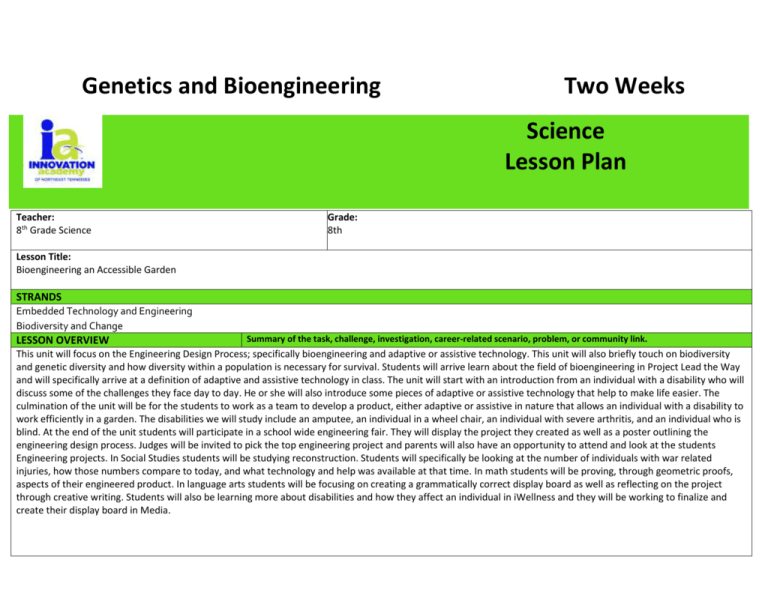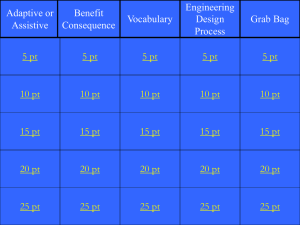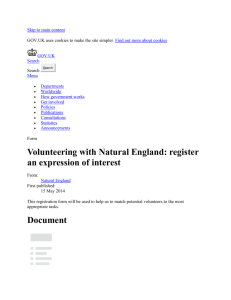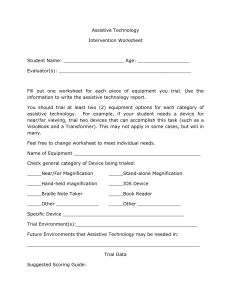8th Science Genetics and Bioengineering
advertisement

Genetics and Bioengineering Two Weeks Science Lesson Plan Teacher: 8th Grade Science Grade: 8th Lesson Title: Bioengineering an Accessible Garden STRANDS Embedded Technology and Engineering Biodiversity and Change LESSON OVERVIEW Summary of the task, challenge, investigation, career-related scenario, problem, or community link. This unit will focus on the Engineering Design Process; specifically bioengineering and adaptive or assistive technology. This unit will also briefly touch on biodiversity and genetic diversity and how diversity within a population is necessary for survival. Students will arrive learn about the field of bioengineering in Project Lead the Way and will specifically arrive at a definition of adaptive and assistive technology in class. The unit will start with an introduction from an individual with a disability who will discuss some of the challenges they face day to day. He or she will also introduce some pieces of adaptive or assistive technology that help to make life easier. The culmination of the unit will be for the students to work as a team to develop a product, either adaptive or assistive in nature that allows an individual with a disability to work efficiently in a garden. The disabilities we will study include an amputee, an individual in a wheel chair, an individual with severe arthritis, and an individual who is blind. At the end of the unit students will participate in a school wide engineering fair. They will display the project they created as well as a poster outlining the engineering design process. Judges will be invited to pick the top engineering project and parents will also have an opportunity to attend and look at the students Engineering projects. In Social Studies students will be studying reconstruction. Students will specifically be looking at the number of individuals with war related injuries, how those numbers compare to today, and what technology and help was available at that time. In math students will be proving, through geometric proofs, aspects of their engineered product. In language arts students will be focusing on creating a grammatically correct display board as well as reflecting on the project through creative writing. Students will also be learning more about disabilities and how they affect an individual in iWellness and they will be working to finalize and create their display board in Media. Hook for the week unit or supplemental resources used throughout the week. (PBL scenarios, video clips, websites, literature) MOTIVATOR Day 2: “Similarities and Differences” (see appendix A) Students will complete an activity on similarities and differences. Students will be required to work in groups to very quickly establish all of the similarities that the entire group shares. Students will then reflect on this activity with questions about how similarities and differences help to build a group and how they contribute to society as a whole. Day 3: “Class with a Disability” Students will be given different disabilities on a slip of paper (mute, deaf, blind, amputee, etc.) The lesson will then proceed as normal, but students will have to maintain the disability throughout the lesson. After teaching the lesson for day 3, stop with plenty of time left in class to discuss some of the challenges faced during the lesson. This should start as an individual reflection, then a table discussion, and finally a whole class discussion. DAY Objectives (I can….) Materials & Resources Instructional Procedures Differentiated Instruction Assessment Remediation: Formative Assessment: 1 Project Day – See Unit Plan Reengineering and Reconstruction: Enabling a Society – An Introduction 2 I can describe the importance of maintaining the earth’s biodiversity. I can explain iPad Apple TV Similarities and Difference Unit Hook Essential Question(s): 1. How can I describe the importance of maintaining the earth’s biodiversity? 2. How can I explain how adaptive and assistive technology responds to social and economic needs in society? Students can use the biodiversity website (see appendix B) Questioning during class Square, Triangle, how adaptive and assistive technology responds to social and economic needs in society Biodiversity Discussion Questions Protocol for Disability Awareness Biodiversity informational Website (See Appendix B) Set: The start of the lesson will be the unit hook described above and included in appendix A. This activity will give students the opportunity to look at similarities and differences they all have with one another. Teaching Strategy(s): 1. Begin with a discussion on similarities and differences. This discussion should be an extension of the set activity. Instructor should include discussion how everyone is different in some way. These differences can be used to make a group stronger. 2. The discussion on diversity in general will then lead into a discussion on biodiversity in nature. This activity will follow the “ING” model. Students will start by working on the discussion questions individually. Then they will discuss with a neighbor. Finally, they will discuss with a group. End the activity with whole class discussion. 3. Students will then learn about proper protocol when working with individuals who have disabilities. Students will read the Protocol for Disability Awareness document. Have students read each protocol point aloud. After each point allow students to question or comment on the point. Summarizing Strategy: Square, Triangle, and Circle. Students will list 4 things relating to biodiversity that “square with my thinking” , 3 topics relating the biodiversity “angles” they disagree with, and 1 question about biodiversity or disabilities that is “circling” in your head. Students can be heterogeneously grouped to utilize peer tutors and Circle activity Students can be given extra time to prepare responses during dicussion Performance Assessment: Enrichment: Students can serve as peer tutors Students can serve as leaders during the unit hook activity (see appendix A) Individual answers to biodiversity discussion Student participation during in-class discussions Summative Assessment: End of unit culminating event: Engineering Fair 3 I can differentiate between adaptive and assistive engineered products. iPad Apple TV Adaptive and Assistive Technology Presentation Essential Question(s): How can I differentiate between adaptive and assistive engineered products? ½ Project Day – See Unit Plan Reengineering and Reconstruction: Enabling a Society – Planting a Garden Disability cards (See Appendix C) Set: As students enter the room, give all students a different disability card. The instructions are outlined above in the unit hook. Students will work through the lesson with their given disability. Teaching Strategy(s): 1. Start the lesson by asking students to provide a definition for adapt and assist. Students should first develop a definition as individuals and then discuss with their table groups. Come to one definition for each term as a class. 2. Work through the Adaptive and Assistive Technology presentation. Have students take notes during the presentation. Students will learn about different products that are considered adaptive or assistive. 3. Once the presentation is complete, have students remove their disability. Students will then discuss the challenges they faced during a normal class period. Have some table discussion and then entire class discussion. Remediation: Students will be given a copy of the notes for Adaptive Assistive Presentation Formative Assessment: Definitions of Adaptive and Assistive In class observations and questioning Students will be heterogeneously 2$ summary grouped to allow peer Performance tutoring and Assessment: collaboration Discussion at the Enrichment: conclusion of the disabilities activity Students can Summative assist others Assessment: with research. Homework Assignment End of unit culminating event: Summarizing Strategy – $2 summary – Each word is worth 10 cents. Students will create a $2 summary about the challenges they faced during the lesson while having a handicap. Engineering Fair Homework: Choose one adaptive bioengineering technology and one assistive bioengineering technology to draw. Divide your paper into two sections and draw and color each. Label the item and write one sentence on how each piece of technology can help organisms in their daily lives. 4 I can describe and explain adaptive and assistive bioengineered products. I can explore how technology responds to social, political, and economic needs. iPad Apple TV Adaptive and Assistive Technology Handout Adaptive and Assistive Products Video 1 Essential Question(s): 1. How can I describe and explain adaptive and assistive bioengineered products. 2. How can I explore how technology responds to social, political, and economic needs? ½ Project Day – See Unit Plan Reengineering and Reconstruction: Enabling a Society – Researching the Disability Adaptive and Assistive Products Video 2 Research Logs Reliable Website Rubric Frayer Diagram (See Appendix D) Remediation: Heterogeneous grouping Providing a handout on adaptive and assistive products Enrichment: Heterogeneous Grouping and peer tutoring Set: Play the two YouTube videos in the resources outlining several different types of products that are adaptive or assistive. Have students determine if each product is adaptive or assistive. Teaching Strategy(s): 1. Students will use the day today to locate and evaluate resources that can be used in conjunction with the unit project. Students will already have been assigned a specific disability and they will have time to continue research. 2. Pass out the research logs and reliable resource rubrics. Demonstrate how to use the log as well as the rubric. Formative Assessment: Questioning during the presentation Observations and questioning during the research Think, Pair, Share Frayer Diagram Homework Performance Assessment: Internet research and evaluation by the rubric Summative Assessment: End of unit culminating event: engineering Fair 3. Lead a short discussion on information students will want to research. This includes products that have already been created, specific challenges associated with a given disability, materials that could be used to create a product, and any general information on how individuals garden with a disability. 4. As students conduct research allow students who locate good resources to airplay the given website and summarize the results to the rest of the class. Students should also be completing the research logs and summarizing each source they locate. Summarizing Strategy: Think, Pair, Share. Have each student share one new product, technology, or piece of information about the given disability with another student. Then have individual students pair up and share this fact with a partner. Have students repeat with several partners. Homework: Students will create a frayer diagram with some key vocabulary relating to engineering: Bioengineering, Adaptive Technology, Assistive Technology 5 Project Day – See Unit Plan Reengineering and Reconstruction: Enabling a Society – Asking, Imagining, and Planning the Product 6 I can distinguish between the intended benefits and Google Drive Assessment iPad Rough sketch of Essential Question(s): How can I identify the tools and procedures needed to test the design features of a prototype? Set: The Google drive assessment will serve as the hook for the lesson. Remediation: Formative Assessment – Students will be heterogeneously Google Drive Form grouped based Questioning and the unintended consequences of a new technology product from Reengineering and Reconstruction: Enabling a Society project Practice TCAP tests Apple TV Doceri or PDF Notes app Picture of New Technology (such as Xbox 1) (See Appendix E) Students will complete the online assessment to determine understanding of adaptive and assistive products as well as prior knowledge of intended benefits and unintended consequences of new products. Students will also discuss the intended benefits and unintended consequences of a well know technology (in this case the Xbox 1) as a hook to this portion of the lesson. Teaching Strategy(s): 1. Begin the lesson by looking at several examples of TCAP questions on the topic of adaptive and assistive bioengineered products. Ask students to provide a definition of adaptive and assistive. Also provide students with a definition, if the given definition is unsatisfactory. Discuss the solutions to the problems with the entire class 2. Lead into the topics of intended benefits and unintended consequences. Display a picture of a well-known piece of technology, such as an Xbox 1. Have students brainstorm individually a list of intended benefits and unintended consequences of this new technology. 3. Once all students have had ample time to brainstorm alone, allow time for some class wide discussion. Start very broad and get more specific to the technology. Create a running list on the board or on the image of the technology. 4. The instructor should then introduce the idea of testing a product “in the mind” before actually creating the product. 5. Students will then take turn airplaying their new technology. Students will have an opportunity to list the intended benefits and unintended consequences of each group’s technology. The presenter will take notes and return on the next project day to their group to present their findings. Summarizing Strategy: Students will complete the post-assessment at the conclusion of the lesson. It will mirror the pre-assessment and give feedback as to what students learned during the lesson and what may need to be re- on prior performance and assessment. Instructor can direct specific questions designed for students needing intervention during the group discussion. Enrichment: Students can be asked to lead off the discussion on intended benefits and unintended consequences. Students can also be asked specific advancing questions during the class discussion. Students can then share what they have group discussion Performance Assessment – Observation of student discussion and critical thinking during the new technology discussion and student created products discussion. Summative Assessment – End of Unit culminating event: Engineering Fair 7 I can Identify the tools and procedures needed to test the design features of a prototype. iPad Apple TV Adaptive or Assistive Product Design Scientific Method Record Sheet Identify the Variables Activity (See Appendix F) covered. learned with the rest of the class. Essential Question(s): How can I identify the tools and procedures needed to test the design features of a prototype? Remediation: Heterogeneous grouping and peer tutors Set: Pose the following scenario to the students: “How can we test if hand sanitizer does in fact kill 99.9% of germs?” Have students brainstorm a way that this can be tested. They should identify the independent, dependent, and Provide students with extra control variables. guidance while Teaching Strategy(s): creating procedures 1. Have a short discussion in review of types of variables. Relate back to the set activity. Enrichment: 2. Review the differences between the EDP and the Scientific Method. Peer tutoring Students will need to test if the claims they make about their device are true. Therefore they will be completing the scientific method within the context of the EDP. Have students meet with their partner to come up with one similarity and one difference between the two processes. Have student pair’s pair up to share these similarities and differences. 3. Instruct students on how to complete the scientific method record sheet. Work through the example from the set. 4. Students will complete the scientific method record sheet to design an experiment to test their product created during the project days. Summarizing Strategy: Students will work through the “identify the variables” activity. Students will complete the first example in class and then complete Students can provide assistance to other students while creating Formative Assessment – Observation and questioning during class Set activity questioning and brainstorming Summarizing activity In-class research work Homework activity Summative Assessment – End of unit culminating event: Engineering Fair the rest for homework. Homework: Students will complete the Identify the Variables activity as homework. 8 Project Day – See Unit Plan Reengineering and Reconstruction: Enabling a Society – Creating the Product 9 Project Day – See Unit Plan Reengineering and Reconstruction: Enabling a Society – Improving the Product 10 Project Day – See Unit Plan Reengineering and Reconstruction: Enabling a Society – Finalizing the Product STANDARDS Identify what you want to teach. Reference State, Common Core, ACT College Readiness Standards and/or State Competencies. GLE 0807.T/E.1 Explore how technology responds to social, political, and economic needs. GLE 0807.T/E.3 Compare the intended benefits with the unintended consequences of a new technology. GLE 0807.T/E.4 Describe and explain adaptive and assistive bioengineered products. GLE 0807.5.5 Describe the importance of maintaining the earth’s biodiversity. SPI 0807.T/E.1 Identify the tools and procedures needed to test the design features of a prototype. SPI 0807.T/E.3 Distinguish between the intended benefits and the unintended consequences of a new technology. SPI 0807.T/E.4 Differentiate between adaptive and assistive engineered products (e.g., food, biofuels, medicines, integrated pest management). SPI 0807.5.4 Identify several reasons for the importance of maintaining the earth’s biodiversity.






